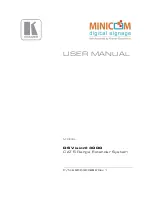
© National Instruments
|
A-3
GPIB-120B User Manual
and receive message bytes on the data lines without transmission error. Table A-1 summarizes
the GPIB handshake lines.
Interface Management Lines
Five hardware lines manage the flow of information across the bus. Table A-2 summarizes the
GPIB interface management lines.
Physical and Electrical Characteristics
Devices are usually connected with a cable assembly consisting of a shielded 24-conductor cable
with both a plug and receptacle connector at each end, as shown in Figure A-1. With this design,
you can link devices in a linear configuration, a star configuration, or a combination of the
two configurations. Figure A-2 shows the linear and star configurations.
Table A-1.
GPIB Handshake Lines
Line
Description
NRFD (not ready for data)
Listening device is ready/not ready to receive a message byte.
Also used by the Talker to signal high-speed GPIB transfers.
NDAC (not data accepted)
Listening device has/has not accepted a message byte.
DAV (data valid)
Talking device indicates signals on data lines are stable (valid)
data.
Table A-2.
GPIB Interface Management Lines
Table Head
Table Head
ATN (attention)
Controller drives ATN true when it sends commands and false
when it sends data messages.
IFC (interface clear)
System Controller drives the IFC line to initialize the bus and
make itself CIC.
REN (remote enable)
System Controller drives the REN line to place devices in
remote or local program mode.
SRQ (service request)
Any device can drive the SRQ line to asynchronously request
service from the Controller.
EOI (end or identify)
Talker uses the EOI line to mark the end of a data message.
Controller uses the EOI line when it conducts a parallel poll.
















































